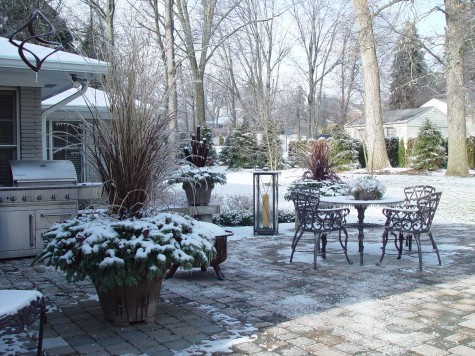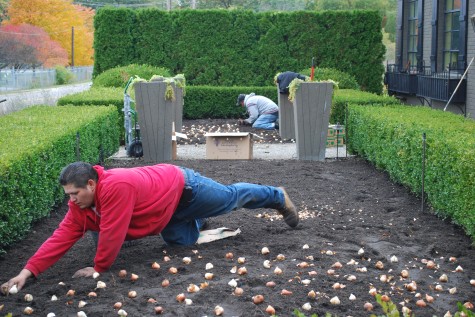
I am embarassed to admit I did not take the time to plant a single tulip last fall-how lame. But I had the entire spring season to regret that decision at my leisure. They smell divine; the colors are not only luscious, they are so welcome after our long grey winter. They are swell as cut flowers. So what was my problem? It is easy to let the spring bulb planting slide, especially if the fall weather is nasty. I am not particularly fond of gardening in freezing weather, beyond digging myself a shelter in the compost pile, and settling in there for a hot lunch and warm apple pie with coffee. Planting bulbs is not especially satifying. You repeat the work of little holes six to eight inches deep times the numbers of bulbs you have; all the while your hands, nose and feet are going numb from the cold . When you have finished, you have nothing to show for your work-just the same dirt surface that was there before you started.
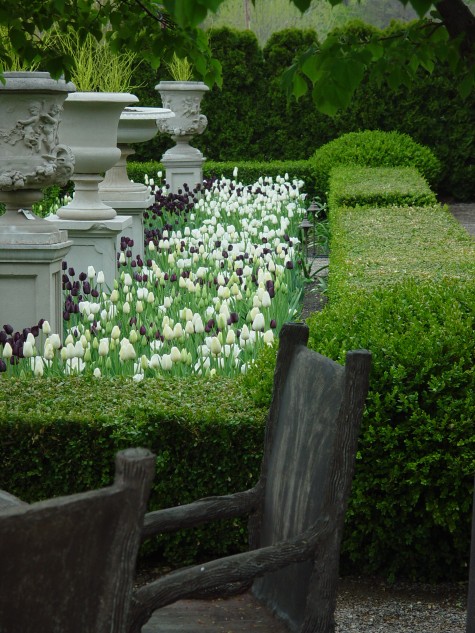 They say delayed gratification is the most adult of all pleasures, so maybe I was being childish about the long hiatus between the planting and the blooming. But when spring finally comes, tulips deliver. It is no small miracle that those small white bulbs with their papery brown covers become a plant that can reach thirty inches tall or better, with strikingly large flowers. Even people whose vocabulary does not include the word “garden”, know the word tulip.
They say delayed gratification is the most adult of all pleasures, so maybe I was being childish about the long hiatus between the planting and the blooming. But when spring finally comes, tulips deliver. It is no small miracle that those small white bulbs with their papery brown covers become a plant that can reach thirty inches tall or better, with strikingly large flowers. Even people whose vocabulary does not include the word “garden”, know the word tulip.
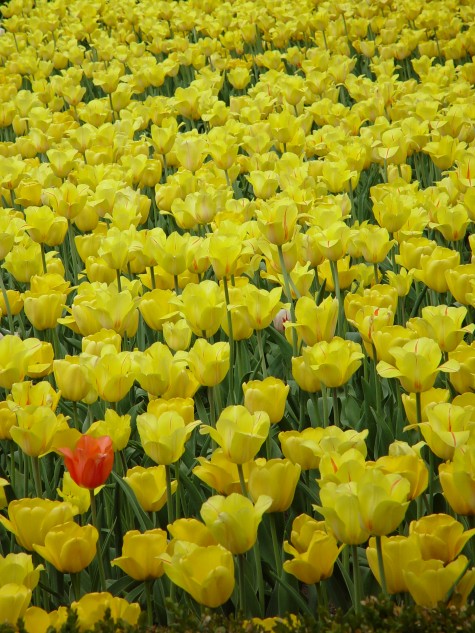 As is my habit, I welcome the one odd plant out in any mass planting. This ocean of Mrs. John Sheepers is all the better looking for it. The blooming of the tulips is one of those garden moments to be treasured. I certainly was not thinking about how cold it was the day I planted , on this spring day. My tulips shake off any late frost; most of any damage is to the leaves that appear early. They are remarkably resilient to rain and wind.
As is my habit, I welcome the one odd plant out in any mass planting. This ocean of Mrs. John Sheepers is all the better looking for it. The blooming of the tulips is one of those garden moments to be treasured. I certainly was not thinking about how cold it was the day I planted , on this spring day. My tulips shake off any late frost; most of any damage is to the leaves that appear early. They are remarkably resilient to rain and wind.
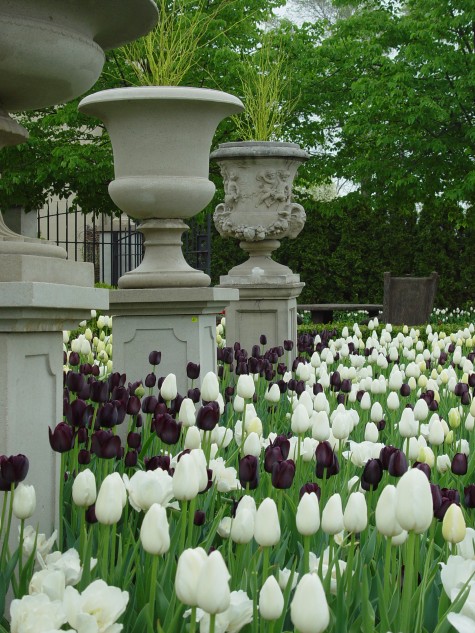 Despite some literature to the contrary, I would not describe a tulip as a perennial. Once they flower, the top size bulb breaks down into smaller bulbs and bulbils. As flower size is directly related to the size of the bulb, a smaller bulb, or collection of will produce smaller flowers, or possibly, no flowers at all. In Holland, once the tulips have bloomed, the bulbs are dug up, sorted as to size and replanted for growing them back to top size. I do not want to dig tulips, separate the bulbs and replant; the Dutch do a much better job of this than I could. This is a long way of saying that I treat my tulips as annuals. When they are done flowering, I dig them and give them away, or compost them.
Despite some literature to the contrary, I would not describe a tulip as a perennial. Once they flower, the top size bulb breaks down into smaller bulbs and bulbils. As flower size is directly related to the size of the bulb, a smaller bulb, or collection of will produce smaller flowers, or possibly, no flowers at all. In Holland, once the tulips have bloomed, the bulbs are dug up, sorted as to size and replanted for growing them back to top size. I do not want to dig tulips, separate the bulbs and replant; the Dutch do a much better job of this than I could. This is a long way of saying that I treat my tulips as annuals. When they are done flowering, I dig them and give them away, or compost them.
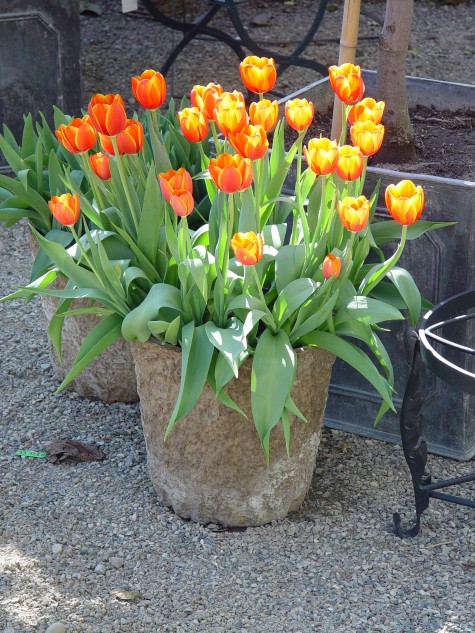 Daffodils are a much better choice of a spring flowering bulb, should you have a requirement that your bulbs rebloom reliably. But they are not tulips. Treating the tulips as annuals permits me to plant them in places where I will later plant summer annuals. As I do not discriminate against summer flowering plants that are only able to grace my garden for one year, so why not have tulips?
Daffodils are a much better choice of a spring flowering bulb, should you have a requirement that your bulbs rebloom reliably. But they are not tulips. Treating the tulips as annuals permits me to plant them in places where I will later plant summer annuals. As I do not discriminate against summer flowering plants that are only able to grace my garden for one year, so why not have tulips?
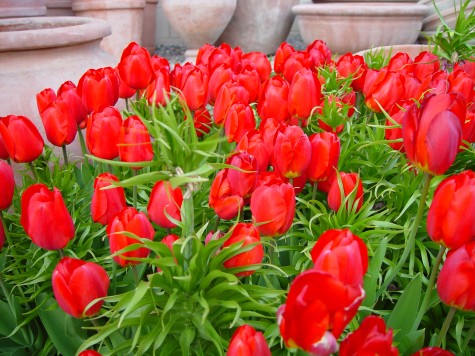
More often than planting in the ground, I do manage to plant tulips in containers which I winter in the garage, or under a thick coating of compost outdoors. I may plant boxes or baskets or galvanized buckets-whatever seems handy. I also may companion plant; the basket of red tulips pictured above was planted in tandem with the giant frittilaria imperialis. The frits were done blooming, but their curly foliage was attractive with the tulips.
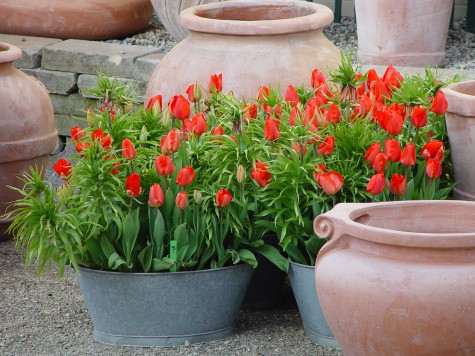
Tulips in containers have the added advantage of mobility. They can be moved to a good spot in a spring garden, or placed on a table, or delivered to a friend who is ill. It also enables me to plant standing up, in the shelter of my garage.

I did plant tulips yesterday-1800 in all. I did a mix of World Expression, Avignon, Maureen and Cum Laude. Should you be interested in checking out my choices, or planting some tulips of your own, I highly recommend Sheepers. www.johnsheepers.com They have a great website, with pictures that will make your mouth water. It is not too late for you to have tulips in the spring.
 Given that I took this picture September 24, why wouldn’t I be unprepared for the weather here this past week? Just three weeks ago, I still had my summer. Though describing any Michigan weather as “ordinary” is glossing over the truth, our weather ordinarily cools off at a slow enough pace to make keeping up with the job of putting the garden to sleep relatively easy. My fall cleanup and shovelling out is based on the distinction I draw between gardening, and housekeeping.
Given that I took this picture September 24, why wouldn’t I be unprepared for the weather here this past week? Just three weeks ago, I still had my summer. Though describing any Michigan weather as “ordinary” is glossing over the truth, our weather ordinarily cools off at a slow enough pace to make keeping up with the job of putting the garden to sleep relatively easy. My fall cleanup and shovelling out is based on the distinction I draw between gardening, and housekeeping.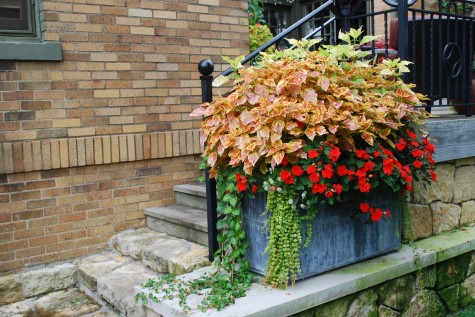 I have seen those properties that look as though every shred of organic debris has been blown, vacuumed up and disposed of weekly; anyone who has inadvertently turned a blower on themselves realize what an invasion they are. Every green leaf looks dusted; every surface has been swept, every shred or organic debris is bagged and removed. The stone is scrubbed clean, and the cushions are only on the furniture when company is in attendance. I like the look of cultivated soil as well as the next person, but all of the above is housekeeping, not gardening. Years ago a gardener whom I greatly respect, Marge Alpern, told me she disturbed her plants as little as possible. She maintained that plants can be worried such that they refuse to prosper. I think this is a point well taken. I will not take on the perennial gardens until much later in the fall.
I have seen those properties that look as though every shred of organic debris has been blown, vacuumed up and disposed of weekly; anyone who has inadvertently turned a blower on themselves realize what an invasion they are. Every green leaf looks dusted; every surface has been swept, every shred or organic debris is bagged and removed. The stone is scrubbed clean, and the cushions are only on the furniture when company is in attendance. I like the look of cultivated soil as well as the next person, but all of the above is housekeeping, not gardening. Years ago a gardener whom I greatly respect, Marge Alpern, told me she disturbed her plants as little as possible. She maintained that plants can be worried such that they refuse to prosper. I think this is a point well taken. I will not take on the perennial gardens until much later in the fall. A series of nights with temperatures hovering in the mid thirties left my pots looking like this-devastated. It does not matter one bit that I know this day is coming, I am never ready for it, nor do I like it. I do not like to let go. On a much more dramatic scale than the time changing to daylight savings, I adjust slowly, and poorly.
A series of nights with temperatures hovering in the mid thirties left my pots looking like this-devastated. It does not matter one bit that I know this day is coming, I am never ready for it, nor do I like it. I do not like to let go. On a much more dramatic scale than the time changing to daylight savings, I adjust slowly, and poorly.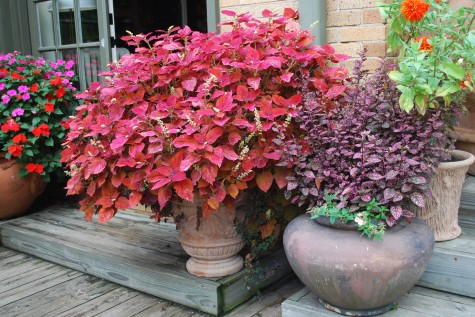 Coleus are astonishingly intolerant of cold weather. Anyone who does poorly with them is probably planting them out too early; every plant thrives in some conditions, and sulks in all else. This five foot diameter fiery orange ball was glorious all season; in late August the corgis were breaking off the branches encroaching on the doorway. They keep the extreme understory clear of any obstructions.
Coleus are astonishingly intolerant of cold weather. Anyone who does poorly with them is probably planting them out too early; every plant thrives in some conditions, and sulks in all else. This five foot diameter fiery orange ball was glorious all season; in late August the corgis were breaking off the branches encroaching on the doorway. They keep the extreme understory clear of any obstructions.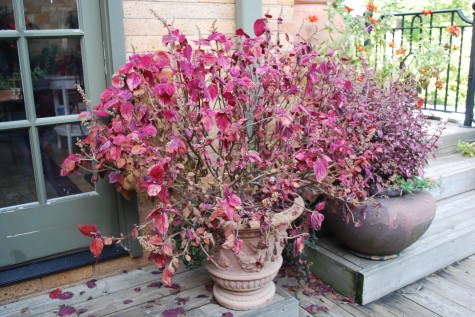 In what seemed like the blink of an eye my fireball shed almost every leaf. Unlike the gingko tree which sheds every leaf on that certain perfect fall day, leaving a beautiful pool of yellow on the ground, the coleus leaves dessicate, drop, and disappear before you can even mourn properly.
In what seemed like the blink of an eye my fireball shed almost every leaf. Unlike the gingko tree which sheds every leaf on that certain perfect fall day, leaving a beautiful pool of yellow on the ground, the coleus leaves dessicate, drop, and disappear before you can even mourn properly. 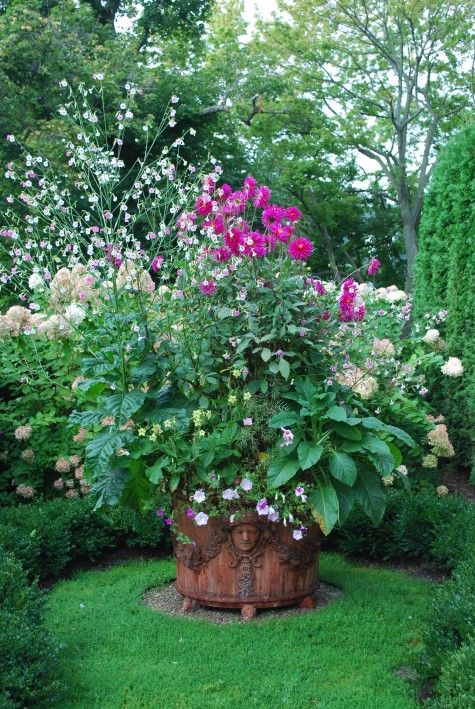 My English-made Italian style pots were home to the biggest bouquet I have ever grown. The nicotiana mutabilis got busy throwing spikes in September, and the dahlias were blooming profusely. I like that extravagant and exuberant look. No matter how the day had gone, I could go home and congratulate myself on having grown one of the annual wonders of the western world. You may be laughing, but how the look of it pleased and cheered me.
My English-made Italian style pots were home to the biggest bouquet I have ever grown. The nicotiana mutabilis got busy throwing spikes in September, and the dahlias were blooming profusely. I like that extravagant and exuberant look. No matter how the day had gone, I could go home and congratulate myself on having grown one of the annual wonders of the western world. You may be laughing, but how the look of it pleased and cheered me. 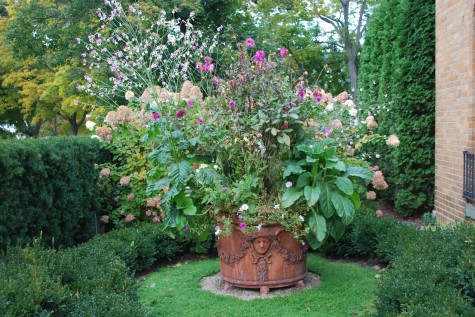 Though the nicotiana mutabilis is yet bravely defending its home, the cold pierced the heart of the whole. Buck is always amazed and amused and the depth and breadth of the despair which attends the beginning of the end of my gardening year. I alternately rage and whine-he murmurs, and pours the wine.
Though the nicotiana mutabilis is yet bravely defending its home, the cold pierced the heart of the whole. Buck is always amazed and amused and the depth and breadth of the despair which attends the beginning of the end of my gardening year. I alternately rage and whine-he murmurs, and pours the wine.  This sister to my pots, adapted for use as a fountain, bears all the signs of a season’s worth of mineral laden water, weather,heat and growth. Does that gorgeous Italianate face not seem completely grief stricken?
This sister to my pots, adapted for use as a fountain, bears all the signs of a season’s worth of mineral laden water, weather,heat and growth. Does that gorgeous Italianate face not seem completely grief stricken? 

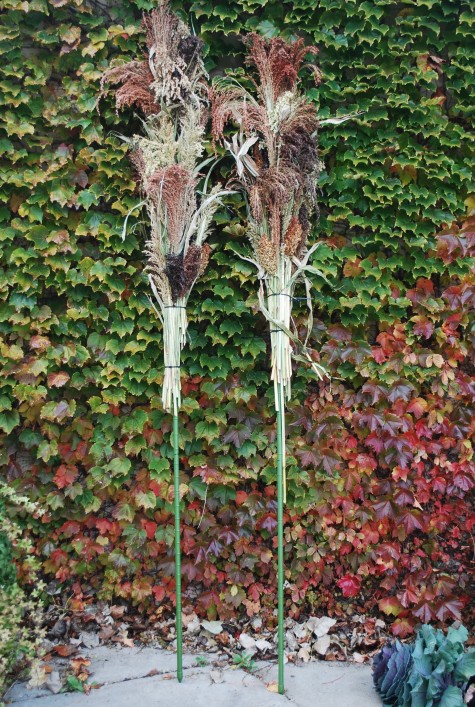
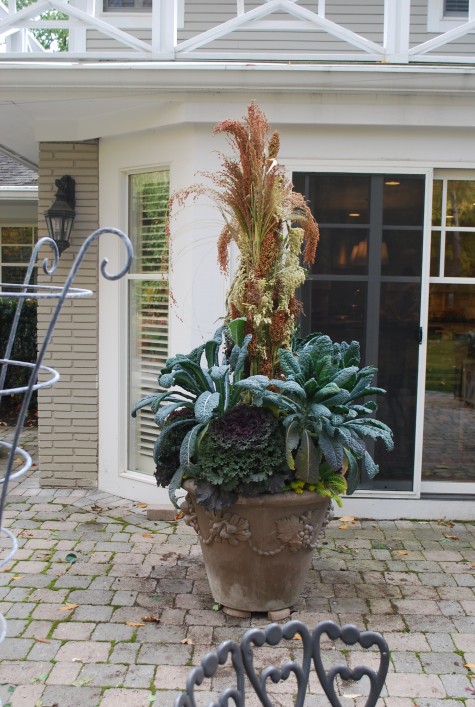 The metal stake is inserted as close to the bottom of the pot as possible. A listing, out of vertical centerpiece-on my top ten list of things I really dislike. The long fibrous panicle of the broomcorn plant arches over gracefully in a pot. I repeat that graceful arching with some leggy Tuscan blue kale; this combination is a good foil for those utterly organized cabbages.
The metal stake is inserted as close to the bottom of the pot as possible. A listing, out of vertical centerpiece-on my top ten list of things I really dislike. The long fibrous panicle of the broomcorn plant arches over gracefully in a pot. I repeat that graceful arching with some leggy Tuscan blue kale; this combination is a good foil for those utterly organized cabbages. 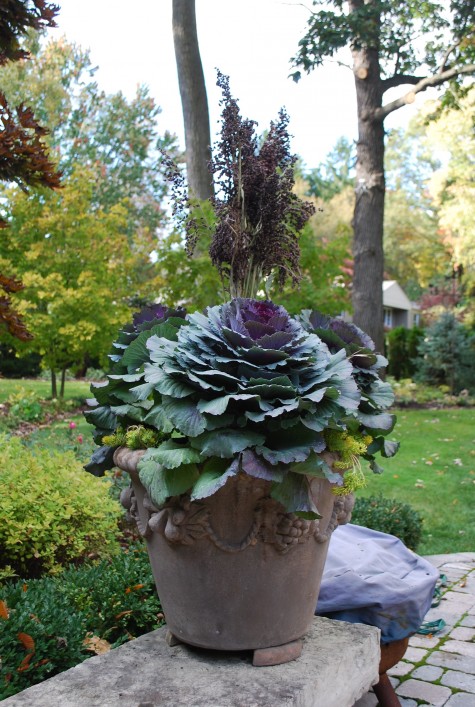 Sometimes I sort the broomcorn bunches for color. The dark stems are a beautiful compliment to this Francesco Del Re pot; plugs of angelina sedum infill the gaps. As I discussed yesterday, elevating the pots allows water to drain away freely. We will need this when dressing the pots for the winter.
Sometimes I sort the broomcorn bunches for color. The dark stems are a beautiful compliment to this Francesco Del Re pot; plugs of angelina sedum infill the gaps. As I discussed yesterday, elevating the pots allows water to drain away freely. We will need this when dressing the pots for the winter. The green-cream and peach sorghum contrasts well with its counterpart in a dark purple-brown. I do not know if any of these stems would pass muster for broom-making material, but they make for a great fall pot. That blue kale foliage is an unusual color in Michigan landscapes; it stands out.
The green-cream and peach sorghum contrasts well with its counterpart in a dark purple-brown. I do not know if any of these stems would pass muster for broom-making material, but they make for a great fall pot. That blue kale foliage is an unusual color in Michigan landscapes; it stands out. Ornamental cabbages only get better as the night temperatures drop; they color up. They are best planted as a tutu. Plants with a stiff aspect need some friendly and loose companionship. Thus this combination. The lime green angelina will take on an orange cast in cold weather, as in 37 degrees when I came to work this morning.
Ornamental cabbages only get better as the night temperatures drop; they color up. They are best planted as a tutu. Plants with a stiff aspect need some friendly and loose companionship. Thus this combination. The lime green angelina will take on an orange cast in cold weather, as in 37 degrees when I came to work this morning.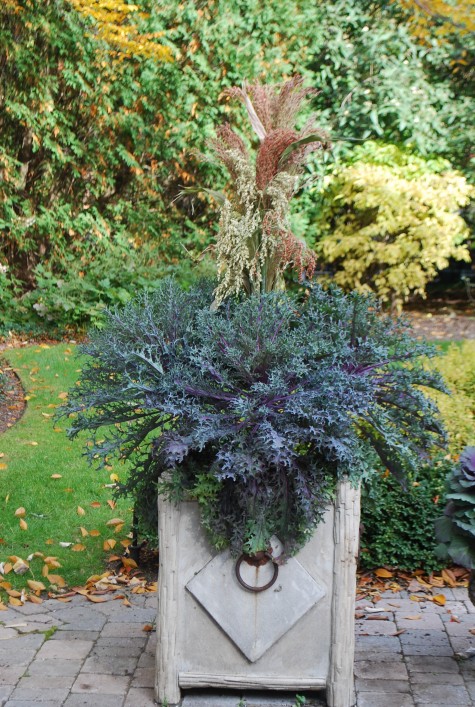 This lace leaf kale is all about air, at the same time that it defines an overall shape. What more could any gardener ask of a plant? As kales and cabbages shed their lower leaves, I may bury the trunk as needed in the soil, and pitch the head forward some. The entire arrangement-saucy enough to attract attention.
This lace leaf kale is all about air, at the same time that it defines an overall shape. What more could any gardener ask of a plant? As kales and cabbages shed their lower leaves, I may bury the trunk as needed in the soil, and pitch the head forward some. The entire arrangement-saucy enough to attract attention. 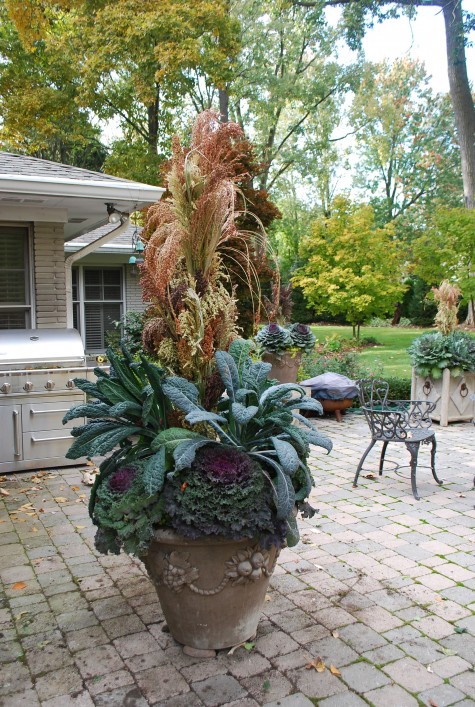

 Some forms are simply done, and reminiscent of the classic rolled rim terre cotta pot which has served gardeners well for centuries. Handmade terre cotta is fired for a long time-relative to the few hours allotted most machine made pots. This slow firing improves the strength and chip resistance remarkably. The flared shape makes potting and unpotting easy.
Some forms are simply done, and reminiscent of the classic rolled rim terre cotta pot which has served gardeners well for centuries. Handmade terre cotta is fired for a long time-relative to the few hours allotted most machine made pots. This slow firing improves the strength and chip resistance remarkably. The flared shape makes potting and unpotting easy.  Francesco Del Re fires their pots until they vitrify. Vitreous china and pottery refers to a clay which is subjected to sufficiently high heat for a time sufficient to turn the minerals in the clay glass-hard. I have left my handmade Italian pots out on occasion to weather the brutal Michigan winter-not a problem. But I am careful about certain things. I make sure there is a space, however small, between the pot, and the hard surface on which it sits. I might slide galvanized metal washers, or nickels under the pots. I want to insure that water drains away before it freezes and expands. Any water trapped under the pot will wreak havoc over a winter; thus I never recommend a winter outdoors for terre cotta to a client.
Francesco Del Re fires their pots until they vitrify. Vitreous china and pottery refers to a clay which is subjected to sufficiently high heat for a time sufficient to turn the minerals in the clay glass-hard. I have left my handmade Italian pots out on occasion to weather the brutal Michigan winter-not a problem. But I am careful about certain things. I make sure there is a space, however small, between the pot, and the hard surface on which it sits. I might slide galvanized metal washers, or nickels under the pots. I want to insure that water drains away before it freezes and expands. Any water trapped under the pot will wreak havoc over a winter; thus I never recommend a winter outdoors for terre cotta to a client.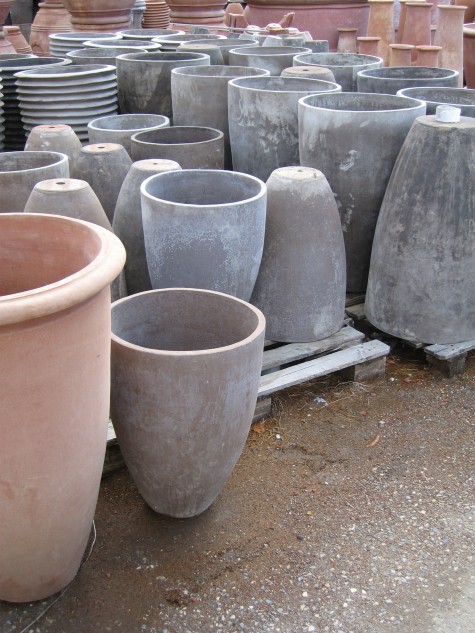
 The pottery is guided by the design work of Elettra Brancolini; they refer to her as their artistic heart. Her distinctive design I would describe as softly modern, sometimes updated classical, and frequently very contemporary. I admire that the pottery has put their weight behind her hand. I am sure she gardens; the pots have a generous space at the top to plant. The proportions of this pot in all its sizes are perfection. They quietly and beautifully set off any planting. They are as beautiful indoors as out.
The pottery is guided by the design work of Elettra Brancolini; they refer to her as their artistic heart. Her distinctive design I would describe as softly modern, sometimes updated classical, and frequently very contemporary. I admire that the pottery has put their weight behind her hand. I am sure she gardens; the pots have a generous space at the top to plant. The proportions of this pot in all its sizes are perfection. They quietly and beautifully set off any planting. They are as beautiful indoors as out.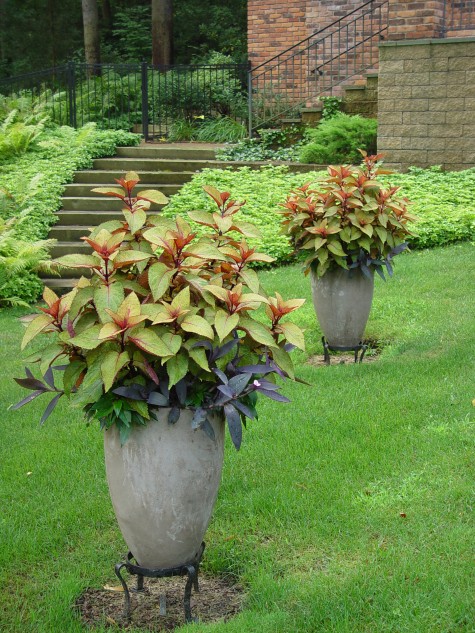
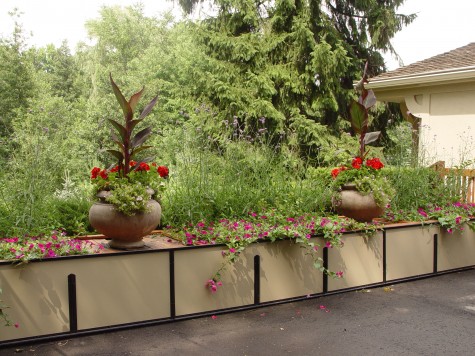 The color of the pots changes with the light, and appears different in different places. The creamy, barely yellow of this retaining wall has brought out the warm brown of the clay. Another cooler colored spot might make the pots read a warm grey.
The color of the pots changes with the light, and appears different in different places. The creamy, barely yellow of this retaining wall has brought out the warm brown of the clay. Another cooler colored spot might make the pots read a warm grey. 
